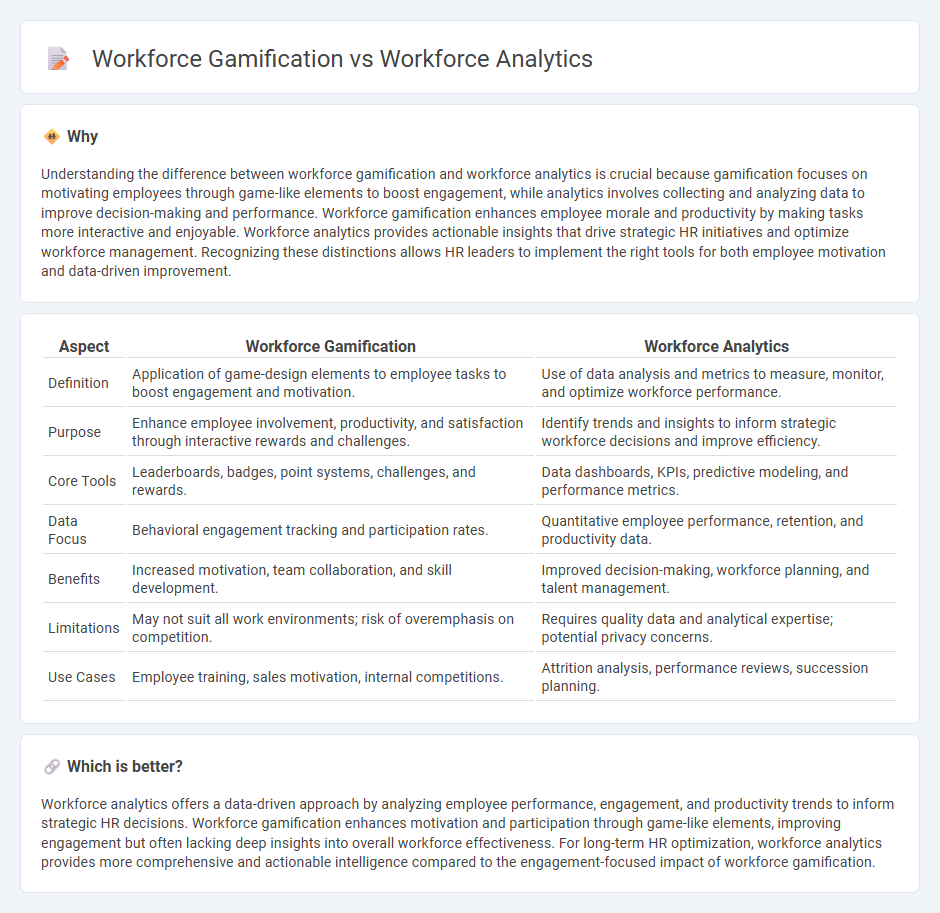
Workforce gamification leverages game-design elements to enhance employee engagement, motivation, and productivity by creating interactive and rewarding experiences. Workforce analytics focuses on collecting, analyzing, and interpreting employee data to drive informed HR decisions, improve talent management, and optimize organizational performance. Discover how combining gamification and analytics can transform human resources strategies and outcomes.
Why it is important
Understanding the difference between workforce gamification and workforce analytics is crucial because gamification focuses on motivating employees through game-like elements to boost engagement, while analytics involves collecting and analyzing data to improve decision-making and performance. Workforce gamification enhances employee morale and productivity by making tasks more interactive and enjoyable. Workforce analytics provides actionable insights that drive strategic HR initiatives and optimize workforce management. Recognizing these distinctions allows HR leaders to implement the right tools for both employee motivation and data-driven improvement.
Comparison Table
| Aspect | Workforce Gamification | Workforce Analytics |
|---|---|---|
| Definition | Application of game-design elements to employee tasks to boost engagement and motivation. | Use of data analysis and metrics to measure, monitor, and optimize workforce performance. |
| Purpose | Enhance employee involvement, productivity, and satisfaction through interactive rewards and challenges. | Identify trends and insights to inform strategic workforce decisions and improve efficiency. |
| Core Tools | Leaderboards, badges, point systems, challenges, and rewards. | Data dashboards, KPIs, predictive modeling, and performance metrics. |
| Data Focus | Behavioral engagement tracking and participation rates. | Quantitative employee performance, retention, and productivity data. |
| Benefits | Increased motivation, team collaboration, and skill development. | Improved decision-making, workforce planning, and talent management. |
| Limitations | May not suit all work environments; risk of overemphasis on competition. | Requires quality data and analytical expertise; potential privacy concerns. |
| Use Cases | Employee training, sales motivation, internal competitions. | Attrition analysis, performance reviews, succession planning. |
Which is better?
Workforce analytics offers a data-driven approach by analyzing employee performance, engagement, and productivity trends to inform strategic HR decisions. Workforce gamification enhances motivation and participation through game-like elements, improving engagement but often lacking deep insights into overall workforce effectiveness. For long-term HR optimization, workforce analytics provides more comprehensive and actionable intelligence compared to the engagement-focused impact of workforce gamification.
Connection
Workforce gamification leverages game design elements to increase employee engagement, while workforce analytics collects and analyzes data on employee performance and behavior. By integrating workforce analytics, organizations can measure the effectiveness of gamification strategies, identify patterns, and optimize employee motivation and productivity. This connection allows for data-driven decision-making that enhances talent management and workforce development initiatives.
Key Terms
**Workforce Analytics:**
Workforce analytics leverages data-driven insights to optimize human capital management by analyzing employee performance, engagement, and retention metrics. This approach uses advanced statistical methods and machine learning algorithms to identify trends, predict workforce needs, and enhance decision-making processes. Explore workforce analytics to unlock actionable intelligence that drives productivity and strategic talent management.
Data-driven decision making
Workforce analytics leverages data mining, statistical analysis, and predictive modeling to optimize employee performance, engagement, and retention, providing actionable insights for strategic HR decisions. Workforce gamification integrates game mechanics like leaderboards and rewards into work processes to boost motivation and productivity through behavioral incentives. Explore how these innovative approaches transform talent management and drive data-driven decision making in modern organizations.
Key performance indicators (KPIs)
Workforce analytics leverages data-driven insights to track and optimize key performance indicators (KPIs) such as employee productivity, engagement, and turnover rates, enabling strategic decision-making for improved organizational outcomes. Workforce gamification employs game-design elements to boost motivation and track KPIs like task completion, participation rates, and skill development, fostering a more engaged and productive workforce. Explore how integrating these approaches can enhance performance measurement and employee engagement in your organization.
Source and External Links
Workforce Analytics: Examples and Best Practices - Workforce analytics uses data to measure workforce performance, identify strengths and weaknesses, and improve talent management strategies to align with business goals, incorporating predictive analytics to forecast trends like turnover and in-demand skills.
What Is Workforce Analytics? Your 2025 A-Z Guide - Workforce analytics systematically uses workforce data in descriptive, diagnostic, and predictive forms to analyze current conditions, root causes, and future trends for optimizing HR decision-making and improving workforce management.
Workforce Analytics: A Comprehensive Guide - Workforce analytics involves collecting and analyzing employee data from various work environments to boost engagement, reduce burnout, and optimize business outcomes with data-driven insights at individual, team, or organizational levels.
 dowidth.com
dowidth.com